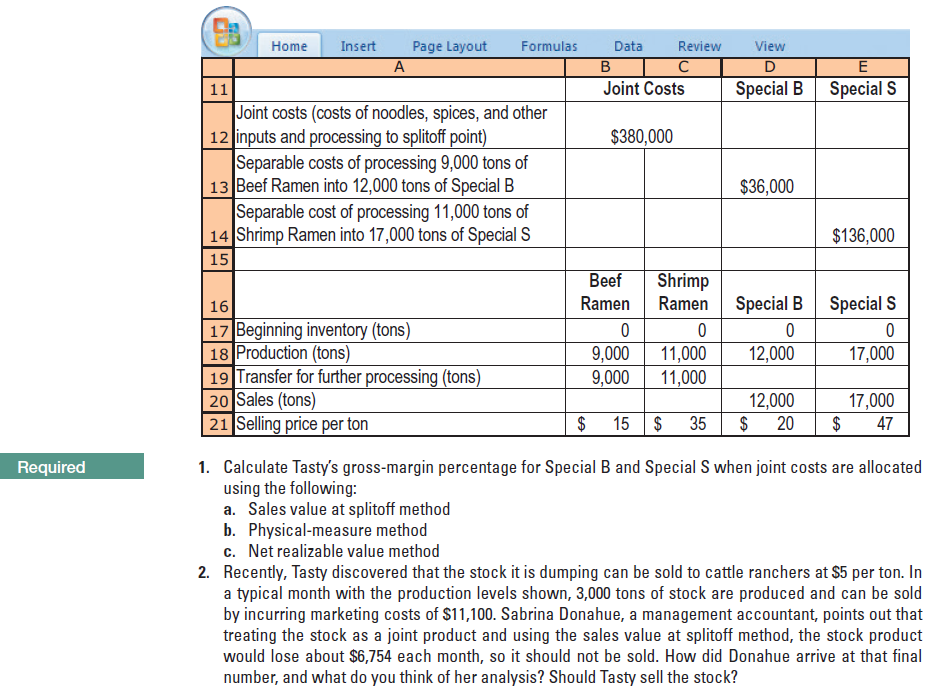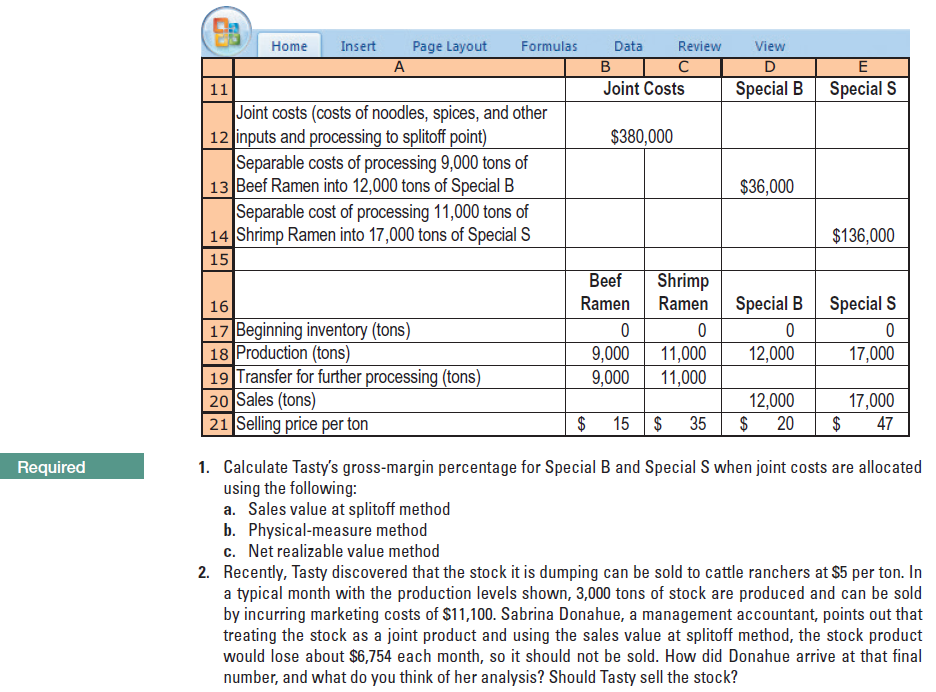Formulas Home Insert Page Layout Data Review View Special S Joint Costs Special B 11 Joint costs (costs of noodles, spices, and other 12 inputs and processing to splitoff point) Separable costs of processing 9,000 tons of 13 Beef Ramen into 12,000 tons of Special B Separable cost of processing 11,000 tons of 14 Shrimp Ramen into 17,000 tons of Special S $380,000 $36,000 $136,000 15 Beef Shrimp Special S Ramen Ramen Special B 16 17 Beginning inventory (tons) 18 Production (tons) 19 Transfer for further processing (tons) 20 Sales (tons) 21 Selling price per ton 17,000 9,000 9,000 11,000 11,000 12,000 12,000 17,000 15 $ 35 20 47 1. Calculate Tasty's gross-margin percentage for Special B and Special S when joint costs are allocated using the following: a. Sales value at splitoff method b. Physical-measure method c. Net realizable value method 2. Recently, Tasty discovered that the stock it is dumping can be sold to cattle ranchers at $5 per ton. In a typical month with the production levels shown, 3,000 tons of stock are produced and can be sold by incurring marketing costs of $11,100. Sabrina Donahue, a management accountant, points out that treating the stock as a joint product and using the sales value at splitoff method, the stock product would lose about $6,754 each month, so it should not be sold. How did Donahue arrive at that final number, and what do you think of her analysis? Should Tasty sell the stock? Required Formulas Home Insert Page Layout Data Review View Special S Joint Costs Special B 11 Joint costs (costs of noodles, spices, and other 12 inputs and processing to splitoff point) Separable costs of processing 9,000 tons of 13 Beef Ramen into 12,000 tons of Special B Separable cost of processing 11,000 tons of 14 Shrimp Ramen into 17,000 tons of Special S $380,000 $36,000 $136,000 15 Beef Shrimp Special S Ramen Ramen Special B 16 17 Beginning inventory (tons) 18 Production (tons) 19 Transfer for further processing (tons) 20 Sales (tons) 21 Selling price per ton 17,000 9,000 9,000 11,000 11,000 12,000 12,000 17,000 15 $ 35 20 47 1. Calculate Tasty's gross-margin percentage for Special B and Special S when joint costs are allocated using the following: a. Sales value at splitoff method b. Physical-measure method c. Net realizable value method 2. Recently, Tasty discovered that the stock it is dumping can be sold to cattle ranchers at $5 per ton. In a typical month with the production levels shown, 3,000 tons of stock are produced and can be sold by incurring marketing costs of $11,100. Sabrina Donahue, a management accountant, points out that treating the stock as a joint product and using the sales value at splitoff method, the stock product would lose about $6,754 each month, so it should not be sold. How did Donahue arrive at that final number, and what do you think of her analysis? Should Tasty sell the stock? Required
Joint-cost allocation, sales value , physical measure, NRV methods. Tasty foods produces two types of microwavable products: beef- flavored ramen and shrimp- flavored . The two products share common inputs such as noodle and spices. The production of ramen results in a waste product referred to as stock, which tasty dumps at negligible costs in a local drainage area. In June 2017, the following data were reported for the production and sales of beef- flavored and shrimp-flavored ramen:
Due to the popularity of its microwavable products, Tasty decides to add a new line of products that targets dieters. These new products are produced by adding a special ingredient to dilute the original ramen and are to be sold under the names special B and special S, respectively. Following are the monthly data for all the products:


Trending now
This is a popular solution!
Step by step
Solved in 5 steps with 5 images


